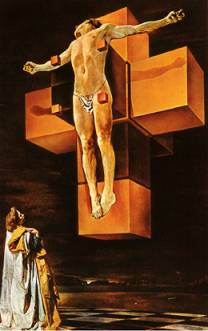Questions & Answers: The Cross
by Catholic Heritage staff writers
This article appeared in the March-April, 1994 edition of Catholic Heritage magazine, formerly published by Our Sunday Visitor, Inc.
The magazine is no longer being published.

As the instrument of Christ's sacrifice on our behalf, the cross is the main symbol of the Christian faith.
During the earliest days of the Church, in the time of the persecutions, the cross was often disguised as a part of other symbols.
Christians did not depict the cross nor the nearly nude Christ on the cross extensively until the fourth and fifth centuries.
From the sixth century to the early Middle Ages, only the empty cross, or the cross of victory, was commonly shown.
In the medieval period, devotion to the suffering Christ led to the depiction of His passion and of His death on the cross.
Today's Catholics revere both the crucifix of the Passion and the cross of victory, frequently using both symbols in devotion and art.
In Eastern iconography, the crucifix is usually flat with a painted corpus.
How much do you know about these symbols of our faith?
- From where did the practice of crucifixion come?
This form of execution for treason, sedition or rebellion was probably first used by the ancient Persians.
The Greeks did not use it often, but the Carthaginians and the Romans used it extensively.
- What was the main point of crucifixion?
Public shame was the key; it was used to discourage rebellion, sedition and escape from slavery.
Among the Romans, the condemned person was forced to carry the horizontal beam through public roads and areas to a public execution site.
Before crucifixion, the prisoner was stripped naked and scourged.
Hands and feet were either nailed or roped to the appropriate beam.
The torso was tied to the vertical beam so as to prevent wriggling free.
Muscle fatigue, exhaustion, stress, hunger and exposure to the elements over a period of days usually led to heart failure or asphyxiation.
The first-century Jewish historian Josephus called it the "most wretched of deaths."
- What shape was the cross of Christ?
The cross used for the crucifixion of Christ was probably tau-shaped (the transverse beam flush with the top of the upright beam) or T-shaped (the transverse beam fitting into the upper half of the upright beam just below the top).
Christian depiction of the cross almost always adopts the latter form.
It is likely that Christ carried only the transverse beam through Jerusalem to Calvary, not the entire cross as is generally shown in art.
- Emperor Constantine brought the early Christian persecutions to an end.
Though he was baptized only on his deathbed, and though he was guilty of murdering his wife and son, his reign brought recognition of Christianity as a lawful religion.
Why did Constantine look with such favor on Christianity?
It is said that just before the Battle of the Milvian Bridge in 312, in which he defeated his rival for the throne, he had seen a cross shining in the sky in broad daylight, together with the words, "By this sign you will conquer!"
On the following night, Christ appeared to him and invited him to have a standard made in the form of a cross, which Constantine did, and which his armies bore triumphantly from then on.
- By whom was the True Cross on which Jesus died said to be discovered about 326?
According to ancient tradition, Saint Helena, the mother of Constantine, searched for and found the True Cross.
Although historical evidence is foggy regarding this claim, there is solid evidence that is was found before 350 and was venerated by pilgrims in Jerusalem, as is attested to by Saint Cyril at the end of the fourth century.
Egeria, the Spanish pilgrim nun, describes veneration of the True Cross on Good Friday, which became a very popular rite brought back to the West by pilgrims to the Holy Land.
At home they venerated replicas of the cross.
- With so many claimed relics of the True Cross, isn't there an improbable amount of wood in the cross?
While there is some cynicism about how many relics there are, in the 19th century Rohault de Fleury catalogued all known relics of the cross and estimated that they constituted less than one-third of the cross thought to have been used in the Crucifixion.
- Besides Good Friday, on what other day does the Church's liturgy celebrate the cross?
On September 13, 335, Constantine's Basilica of the Resurrection was dedicated in Jerusalem.
The next day, the relic of the True Cross was solemnly venerated in the basilica.
Celebrated only in the East at first, by the seventh century the feast spread to the West.
It is celebrated today as the Exaltation of the Holy Cross on September 14.
|


